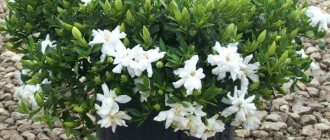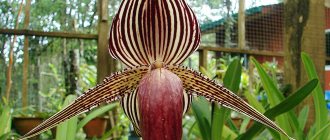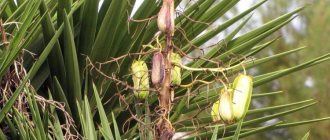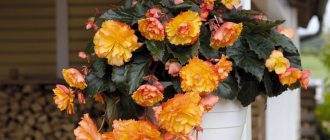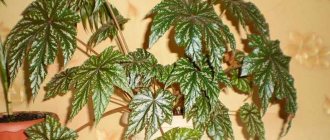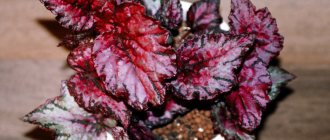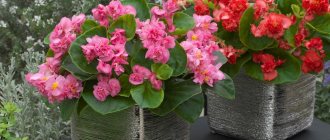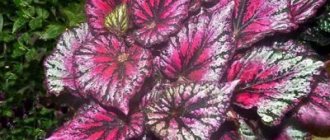Planting begonia seeds for seedlings and caring for them at home is a labor-intensive process that requires constant monitoring. However, by following all the rules of agricultural technology, you can get healthy and beautifully flowering plants for a long time.
Most often, decorative deciduous and ever-flowering begonia species are grown from seeds. However, tuberous varieties can also be obtained through seedlings, although this process is very long and labor-intensive.
Begonia seeds are recommended to be planted at the end of February or in the first ten days of March. At this time, daylight hours quickly increase and maintaining the required temperature becomes easier.
Brief information about the plant
Begonia is a perennial or annual plant that belongs to the Begoniaceae family. There are 1,600 varieties of culture, each of which has its own characteristics.
Begonia was first discovered by Charles Plumier, who took part in an expedition organized by Michel Begon in 1687. In 1690, C. Plumier named the new genus “begonia” in honor of his friend Michel Begon.
The flower's homeland is South America, West Africa, Central and Southeast Asia. It grows naturally in the tropics; when grown at home, a humidity level of at least 60% should be maintained. Ever-flowering varieties and tuberous varieties, which can be planted in open ground in the summer, are very popular.
Choosing a begonia variety
The begonia culture is characterized by attractive inflorescences and is divided into a large number of varieties and subspecies. When choosing a variety for propagation by seed, attention should be paid to the following:
- Deciduous begonia - rarely used for propagation by seed. Purchased at a specialized store and used for further germination.
- Tuberous varieties are most often used for seed propagation. A distinctive feature is the large buds. The plant can bloom for a long time.
- Bush begonia - can be propagated by various methods, including seeds.
Begonia propagation by seeds
Begonia grown from seeds does not lose its characteristics and quickly sprouts for further replanting in a permanent place.
Sowing time
To grow seedlings, you must adhere to certain sowing dates. Begonia requires a lot of light, and planting too early can result in a weak crop.
Regions
The crop has a long growing season, so to obtain seedlings, seeds are usually planted somewhat earlier than other flowers.
- Southern regions - seeds are planted at the end of January.
- Northern regions - in the Urals and Siberia, seeds are sown in mid-March.
- Leningrad region - in early March.
- The middle zone is in early February.
Moon calendar
Climate features make it possible to determine the period of sowing in different regions. Specific dates for sowing begonia seedlings are helped by choosing the lunar calendar, which determines favorable and unsuitable days in the desired month.
You should not sow on the days of the full moon and new moon. The most productive days for sowing are the days during the waxing Moon, but during the waning Moon you can also carry out sowing work.
Planting seedlings
Sowing of ampelous begonia, tuberous, ever-blooming and other varieties is carried out in the same way. The grains of all are small, germination and the time of appearance of sprouts are practically the same.
Seed preparation
It is easier to grow begonia from store-bought seeds. They are already treated against pests and diseases, sold in granules (coated) - covered with a protective shell containing nutrients and increasing their size. Such seeds are convenient to sow and do not need to be processed. Moreover, any disturbance of the integument reduces germination.
Preparing your own planting material involves cleaning the seed pods. This is usually done long before sowing. There is no need to soak, germinate, or stratify begonia.
Soil preparation
The crop is planted in a barren or very light substrate. Each gardener has his own recipe for preparing it, the simplest is to mix neutral peat with sand 1:1. Some people add leaf soil, coconut fiber or sphagnum moss.
The soil must be sifted - if this is not done, even pelleted seeds will sink and slowly germinate.
The substrate is disinfected, not the small begonia planting material. It can be calcined in the oven, sprinkled with Fitosporin, and heated over steam. If you use a solution of potassium permanganate, the soil must first be well moistened with plain water.
Selecting a landing container
It is believed that a 15x20 cm bowl is enough for 300-400 seeds.
Now some gardeners are too carried away with peat tablets. But those who grow a lot of seedlings practically do not use them. And not only because of savings. The seeds germinate there, but the spread of the roots is inhibited by a mesh bag made of non-woven material. It is difficult to pick it off; the begonia gets injured.
Any low containers with bottom holes are suitable for sowing. You can use food containers or small pots, which are then placed in a common box with a transparent lid. If it is not there, cover it with cellophane.
To plant begonia seeds, the holes in plastic containers need to be made large enough. Otherwise, they will become wet when watering and will no longer allow moisture to pass through. You can pierce the bottom with a sharp object, and then widen the holes with a pen or pencil.
Sowing scheme
First, fill the containers with substrate. Level, slightly compact, water with Fitosporin solution.
If there are few seeds and they are pelleted, take a toothpick and lay them out according to a 2x2 cm pattern. Those collected in the flowerbed are sown in a continuous mass on the surface of the soil, without being sprinkled. Cover with glass, transparent cellophane or lower the lid of a plastic container.
Begonia seeds must germinate in light. It has been noticed that if they are planted too sparsely, they will sprout unevenly, and if they thicken, picking becomes more difficult.
Helpful Tips:
- You can sow begonia in the snow - it is laid on the ground and leveled. On a white background you can see how the dark seeds fall; when necessary, correct the grains with a toothpick.
- Another trick: if you mix small seeds you get yourself with sand, it’s easier to make not too dense crops.
- For the same purposes, planting material is poured onto a sheet of white paper folded in the middle. This makes it easier to distribute the seeds evenly.
- After sowing begonias for seedlings, despite the wet soil, you need to lightly spray it with warm water from a spray bottle to slightly drive the seeds into the soil.
Crop care
Begonias are provided with good lighting, a temperature of 20-26 ° C, and high humidity. Ventilate daily, water when condensation has stopped forming on the lid. Warm, settled water is used, and the soil is moistened from a household spray bottle.
After how many days do shoots appear?
If the planting material is fresh, the first shoots will hatch in 10-14 days. For some varieties or hybrids this takes about 20 days.
It is believed that the sowing needs to be renewed if nothing has sprouted in a month. But flower growers wait longer when the weather was cloudy and cool, and it was not possible to add additional light to the bowl or raise the temperature.
Preparing for sowing
In order for planting material to sprout well, not only the soil, but also the planting container should be properly prepared.
Seed selection
Begonia seeds are very small and difficult to process before planting, so this procedure is not carried out.
You can buy granulated seeds at a gardening store; they are much larger and easier to sow.
Soil selection
To grow begonia seedlings at home, you need light, breathable soil. You can choose a ready-made substrate designed specifically for begonias.
You can also make your own soil mixture. To do this, use garden soil, peat, humus and sand in a ratio of 2:2:1:1. Mix everything thoroughly and place on a baking sheet, which must first be covered with baking paper. Fry the soil for 15-20 minutes in the oven at a temperature of 70℃ (instead of heat treatment, the mixture can be spilled with a light pink solution of potassium permanganate).
Selection of capacity
To grow begonias, you can use special containers for seedlings or transparent food containers. In the latter option, be sure to make drainage holes before filling with soil. The optimal height of the container is 10 cm, the width varies depending on the number of seeds.
Before planting the planting material, the containers should be treated with boiling water. This technique eliminates possible fungi and protects the plant from diseases.
Hybrids and varieties for seed propagation
You can plant the seeds of any begonia. Fresh ones, collected on their own site, sprout better, but they do not always guarantee that the bush will be similar to the mother one. Even the propagation of cultivars with seeds purchased at a garden center from trusted producers produces a small percentage of plants that must be discarded due to varietal inconsistency.
Everblooming
Begonia semperflorens is an easy begonia to collect its seeds from. Even if splitting occurs, it is usually minor and only noticeable to specialists. But the planting material of the newest densely double hybrids such as Queen F1 still needs to be bought in the store.
Begonia Everblooming propagates from seeds especially often. The choice is wide; you can always buy cultivars in retail chains:
- Chord;
- Ambassador;
- Alpha;
- Bada Boom;
- Bada Bing;
- Bowsheen;
- Broumov;
- Benary Big;
- Variation;
- Dregen Wing;
- Inferno;
- Queen (Queen);
- Lucenets;
- Magma;
- Nakhod;
- Oreb;
- Olomouc;
- Ostash;
- Padoli;
- Rainbow;
- Senator;
- Rolling pin;
- Sprint.
Chord
Bada Boom
Variation
Lucenec
Ampelous
Slightly less common than Ever-blooming, ampelous begonia is grown from seeds at home. Here they are already looking at the cultivar - some need to be bred vegetatively to match the characteristics of the mother plant.
Popular varieties and hybrids can be obtained from seeds:
- Alcor;
- Bella;
- Venus;
- Galatea;
- Illumination;
- Carmen;
- Cascade;
- Copacabana;
- Margarita;
- Panorama;
- Chanson;
- Sun Dancer;
- Triumph;
- Hip-hop;
- Funky;
- Hellas.
Chanson
Illumination
Margarita
Large-flowered
Among tuberous begonias, cultivars suitable for planting in flower beds are usually grown from seeds. Some of them, for example, the yellow variety Golden Ball, have very large single terry corollas. But there are modern multi-flowered hybrids that are not inferior in beauty to the best indoor varieties, such as the rose-like Novaya Zvezda.
You can find tuberous begonia seeds on sale:
- Go go;
- Imperial;
- Limitless;
- Non-stop;
- Medley;
- Picoti;
- Royal;
- Pink Angel;
- Fortune;
- Fountain.
The list of Elatiors that can be propagated by seed is short. So far these are the series of hybrids Charisma and Renaissance.
Other species and varieties created on their basis
Rhizome, bush, reed, caudex begonias also reproduce by seeds. This is rarely done for the following reasons:
- Usually few new plants are needed;
- due to the difficulty of breeding, hobbyists prefer the vegetative method;
- The varietal discrepancy between decorative leafy cultivars, especially those belonging to the rhizomatous group, is more striking than among beautifully flowering ones.
Planting material of the hybrid Begonia rex Griffon is often found on sale.
Sowing work - step-by-step instructions
Begonia pleases with its flowering throughout the summer until autumn. Propagation by seeds allows you to get a flowering bush in 6 months if all care conditions are met. Step-by-step instructions for sowing seeds:
- A layer of drainage up to 2 cm thick is placed at the bottom of the prepared container for planting. Fine expanded clay is usually used as a drainage material.
- Fill the container with soil mixture, leaving 2 cm at the top so that you can make a greenhouse.
- The soil is moistened with warm water using a spray bottle and left for 20-30 minutes.
- Using tweezers (or a sheet of paper folded in half), distribute the seeds at a distance of 2-3 cm from each other. To make seedlings appear faster, the seeds are not sprinkled with soil on top.
- Cover with plastic film or glass to create a greenhouse effect.
- The container is placed on the windowsill and the temperature is maintained at at least +23℃.
The greenhouse is opened slightly for 30 minutes every day to prevent the seeds from becoming moldy. During the ventilation process, condensation is removed and, if necessary, the soil is moistened. After the first shoots appear, the greenhouse is opened.
If peat tablets are used, planting is carried out according to the following scheme:
- The tablets are placed on a tray 5-10 cm high and watered.
- The material is left in this form for several hours until it swells.
- One seed is placed in each peat puck. For ease of sowing, pelleted seeds are usually used. They are covered with a special shell, since in its natural form a begonia seed looks like a speck of dust.
- Moisten with warm, settled water and cover the tray with film or glass.
Caring for crops in peat tablets is the same as when planting in the ground. The only difference is that you can water the peat washers through a tray. The material absorbs the required amount of liquid well.
Seedling care
- For full development, begonias require regular watering, which is carried out with warm water in a tray or using a syringe under the root.
- Until the seeds have sprouted, the film or glass must be wiped daily to remove accumulated condensation. Plantings also need to be ventilated regularly.
- The seedlings should receive enough daylight, but they should not be exposed to direct sunlight so that the young seedlings do not get burned. Additionally, lighting is provided with fluorescent lamps. If the plants do not have enough lighting, they will begin to stretch out and lose their decorative appearance.
- At first, it may seem that the seedlings are practically not growing. There is no need to worry, since begonia first grows its root system and then begins to develop its above-ground part.
- 2 weeks after the emergence of seedlings, the seedlings need to be fed; for this purpose, fertilizer for deciduous and ornamental plants is used. The fertilizer solution is diluted 3-4 times the dosage recommended in the instructions.
- The soil around the grown seedlings must be loosened periodically.
- After 1-2 true leaves appear, the seedlings are planted.
When will the shoots appear?
Planting material sprouts in 10-14 days. However, in some cases, sprouts do not appear for 3-4 weeks, so there is no need to stop care.
Sometimes shoots appear after 5-6 days and the sprouts freeze in growth. This is considered a normal process for begonias and does not require intervention.
After the first shoots appear, the covering material is removed, otherwise the seedlings may get burned and die.
When does a flower sprout appear?
Begonia elatior flower - home care
Ever-blooming begonia, the seedlings of which appear within 15 days after planting, requires careful care. After emergence, small sprouts reduce their growth rate and freeze for a while. It is important to ensure that the thin shoots are not damaged during watering.
Begonia sprouts after planting
Conditions for growing seedlings at home
As a rule, seedlings appear together. After sprouts appear, it is very important to take proper care. Plants are very sensitive to changes in temperature and humidity levels.
For growing begonia seedlings, the optimal temperature is +21-23 ℃. When the second true leaf appears, the temperature can be reduced to +18 ℃, but no more. Otherwise, the leaves will begin to turn yellow and the crop will die.
The plant prefers a high level of humidity, so moistening is carried out as the top layer of soil dries. To water the seedlings, use a syringe or spray bottle so as not to harm the delicate sprouts. Water the seedlings with warm, settled water.
Transplantation to a permanent place
Tuberous begonia is grown from seeds, planting and caring for planting material is no different from other varieties. After the plant germinates, it is transplanted to a permanent place of growth. Before planting, you should choose the right pot. The container should be medium in size. The roots of the plant have an average degree of development. The root shoots should not be too constrained by the walls of the pot. The steps for transplanting a plant to a permanent place of growth are as follows:
- Small pebbles must be placed in the prepared container as drainage.
- Mix the leaf mixture, peat, sand and humus in equal proportions. The resulting nutrient mixture fits tightly into the pot.
- Moisten the soil thoroughly.
- Make a small hole in the soil.
- Remove the seedlings along with the soil and place them in a new place.
- Compact the soil.
Transplanting seedlings to a permanent place of growth
If peat cups are used, begonia can be planted in a pot together with a peat container. Subsequently, the peat cup will fall into pieces.
Important! It is not recommended to use deciduous soil in areas where oak or willow grows. Such soil may contain tannins that negatively affect plant growth.
Picking - step by step instructions
Picking is necessary so that the begonia seedlings form a strong root system and are transplanted into open ground. For begonias, experienced gardeners carry out 2 picks. The first procedure should begin after the plant has formed its third true leaf. Step-by-step instruction:
- The container with the seedlings is moistened and left for 2 hours so that the water is completely absorbed and the roots are not damaged during the transplantation process.
- Drainage holes are made in new containers if they are missing.
- A drainage layer 3 cm thick is laid on the bottom.
- Fill the container with the soil that was used for planting the seeds and make a hole.
- Using a wooden spatula, carefully separate the sprout along with a lump of soil and transplant it into a new container.
- Compact the soil around the seedling with your fingers and water with warm water.
- The containers are placed on a tray to collect excess liquid during watering and placed on the windowsill.
After the begonia seedlings are planted, in the first 2 days the container with the glasses is slightly shaded so that the begonia can more easily withstand stress. Water the plants after the soil dries. Add moisture to the root using a syringe so that drops of water do not fall on the leaves.
The second picking is carried out 1 month after the first. Step-by-step instruction:
- Take new containers with a diameter of no more than 15 cm and treat them with boiling water or a solution of potassium permanganate.
- A drainage layer of expanded clay or coarse sand is placed at the bottom.
- Fill with the substrate that was used previously.
- Using the transfer method, begonia seedlings are moved to a new container.
The containers are placed in a well-lit place and slightly shaded with paper from direct sunlight.
10 days after the second picking, fertilizing is carried out with complex fertilizers: Agrecol or Helprost.
Possible difficulties in growing and diseases of begonia
Most of the difficulties in the process of growing begonia arise from improper care. Poor care reduces the protective functions of the flower and impairs its decorative effect:
- Begonia, which is demanding on soil, responds to a lack of nutrients in the soil with a complete lack of flowering. To avoid such a problem, the plant must be fed with complex fertilizers every 14 days.
Lack of flowering in begonia - Many gardeners decorate window sills in the kitchen with begonia, not knowing that it reacts poorly to gas combustion products. In response to being in a room where a gas stove is constantly running, the flower will wilt and its leaves will lose their elasticity.
- The root system of begonias quite often becomes covered with rot - this is due to the sensitivity of the flower to waterlogged soil. Excessive watering can lead to rotting of not only the roots, but also the stem.
Root rot - Keeping a flower in a cold room can cause the foliage to drop. Moving the flower to a warm, draft-free location will help restore its leaf mass.
Begonia is susceptible to various diseases, including:
- Bacterial wilt.
- Downy mildew.
- Botrytis.
These diseases are manifested by the appearance of various kinds of spots on the leaf plates of the flower. You can cope with diseases by treating begonia with a systemic fungicide. The cause of all these plant diseases is, as a rule, excessive watering.
Hardening
Hardening of seedlings is a procedure that allows you to prepare a plant for transplanting into open ground. They begin to harden begonia 1 month before planting in open ground.
First, open the window for 20-30 minutes a day and ventilate the room with the sprouts. Gradually the duration of the procedure is increased to a whole day. In spring, when the air temperature warms up to +14 ℃, the crop is taken out onto the balcony or street. This hardening strengthens the begonia and helps increase immunity before a sharp change in temperature.
What affects germination?
In some cases, the seed does not germinate well, and gardeners cannot wait for the sprouts to sprout. The following factors can affect seed germination:
- Improper storage of planting material. In a cold and wet place, sprouts may not appear.
- Insufficient moisture. If there is no regular watering, the soil will dry out and sprouts will not appear.
- Incorrect temperature. In order for the seeds to sprout, you need to place the container with the sprout on the windowsill. The temperature for germination should be at least +25 ℃.
You should know! A long period of storage of seed material can affect the growth of sprouts. Seeds can be used for planting for three years.
Growing from seeds
Independent procurement of raw materials for planting
You can get begonia seeds yourself. But this is a very troublesome matter, because the plant produces very little planting material. The seeds themselves are small, resembling grains of sand. They appear in seed pods. To collect a decent “harvest” of planting material, you need to remember a few recommendations:
- Artificial pollination. When begonias bloom (in July-August), using a brush, you need to carefully transfer the pollen to the stigma of the flower. This procedure is repeated for 2-3 days to increase the chances of successful pollination.
- Collection of raw materials. After pollination, seed pods will form on the begonia. After 45-60 days they will begin to dry out and turn yellow. At this time they need to be collected.
- Drying seeds. The collected boxes are laid out on paper and left to dry. After 1-2 weeks they completely dry out and crack.
The seed pods should not overripe. When dried, they crack easily. In this case, it will not be possible to collect seeds.
Purchase – where, at what price?
If the process of independently obtaining seed stock causes difficulties, then you can purchase planting material in the store. The price of one bag (it contains 4-10 seeds) averages 30-100 rubles, depending on the plant variety.
The store will offer 2 types of seeds:
- Granular. The seeds are in a special shell consisting of a mixture of fertilizers. Such planting material is clearly visible to the eye and is easier to plant in the ground. But it takes a little longer to germinate, although the germination rate is much higher.
- Regular. Small seeds. These raw materials are no different from those grown independently.
Important! When purchasing, you should pay attention to the date of collection of raw materials. The shelf life of planting material is 5 years. But the highest germination rate is for seeds that are no more than 1 year old. With each subsequent year, the chances of obtaining strong plants decrease.
Plant propagation methods
Flower growers use several methods of propagating begonias:
- By cuttings.
- Cut a small stem 10 cm long, containing 2-3 pairs of leaves.
- The cuttings are planted in the ground under a plastic glass or jar.
- A month later, young leaves appear on the plant, indicating the rooting of the begonia.
- Sheets.
This method is used for begonias with a creeping stem.- Healthy leaves are cut in the middle from the vein to the edges.
Such blanks are laid out on wet sand and covered with plastic wrap.
- After approximately 3 months, the begonia is ready to be transplanted into normal conditions.
By dividing the bulb.
This propagation method is suitable for bush varieties (for example, everflowering begonia).- The plant is taken out of the pot and the soil is shaken off.
Using a knife, the rhizome is cut into several parts, each of which must have a sprout or bud.
- The sections are sprinkled with charcoal.
- The resulting plants are planted in new pots.
- Seeds.
This is the most labor-intensive method of crop propagation. It is used only for two types of flowers: ever-flowering begonia, decorative flowering.
Planting a begonia tuber - basic steps
Treatment with drugs
Immediately before planting begonia tubers begins, they should be soaked in a growth stimulator (Epin, Zircon, Stimul, etc.) according to the instructions. In order to protect them from rotting in the future, treat the tubers with a weak solution of potassium permanganate or a fungicide (Maxim, Alirin, Fitolavin, etc.). These events are generally important for all corms, and tuberous begonia is no exception (you can see how to plant other corms in our “Encyclopedia”).
After processing, the tubers can be laid out in rows in trays filled with a damp substrate (peat, sand, cotton cloth, table napkins, toilet paper), covered with film and placed in a warm place for rooting. Remember to ventilate containers and maintain humidity. There are tubers that take quite a long time to germinate. Be patient.
Planting tuberous begonia at home in separate bowls should be planned for March or the end of February, when the nodules give noticeable roots.
IN THE PHOTO: If you get a too “shaggy” tuber, remove some of the old roots and dried soil before planting. It will be easier for young roots to break through.
Choosing a container for planting begonias
Planting tuberous begonia at home begins with choosing a container that best meets the requirements of the plant. For planting, it is worth taking a wide but shallow pot - the root system of the plant is superficial, the roots will not go deep, but there should be enough space in breadth. Select a container of at least three liters. There must be good drainage.
If you are going to transfer begonia to the garden in the future, you can plant it in small liter pots with a diameter of 12 cm.
Let's start planting tuberous begonia
Manufacturers often recommend planting begonia as a tuber to a depth of 5 cm. However, it will be better if you plant it so that the buds are visible. To do this, a small depression is made in well-moistened soil, and then the tuber itself is placed into it and slightly pressed.
IN THE PHOTO: When planting, the edges of the begonia tuber should rise above the soil surface by approximately 0.5-1 cm.
You need to add soil as shoots appear and grow.
Caring for tuberous begonia after planting
After planting the begonia tubers has been completed, place them in pots or on a bright windowsill, but not in direct sunlight. Watering is done sparingly so as not to soak the tubers themselves. They also cannot tolerate dry soil. Watering can be increased when leaves appear on the planted tuberous begonia, but nevertheless, it should be watered moderately and preferably in a tray.
Figuring out how to plant a begonia tuber correctly is only half the battle (albeit quite important). Next, the plant needs to be provided with proper care throughout the growing season. The temperature should be +16–18°C, and the air should be sufficiently humid (40–50%).
The influx of fresh air rich in carbon dioxide will accelerate the growth of begonias. At the same time, do not forget to shade them from the bright sun, to which young plants are very sensitive.
IN THE PHOTO: Arrange the tubers so that there is enough space between them for watering. When watering from above, moisten the soil directly; under no circumstances should water get into the recess on the tuber!
Ampelous indoor begonia
A beautiful plant that is exceptionally suitable for apartments. It begins to bloom in late May - June and delights with its lush decoration until late autumn. This variety is easy to care for and propagates by seeds.
The ampelous variety stands out for its picturesque decorative leaves and curved terry stem. In the wide variety of this group of flowers, there are plants with large inflorescences of about 30 cm and small leaves measuring 4-6 cm.
The flower has a large rhizome, similar to a tuber. From it grow shoots with ornamental leaves, usually covered with hairs. Both female and male flowers grow on the shoots, of all sorts of colors and patterns, with rough or velvety leaves, depending on the species.
Flowers will appear near the 4-6th internode and will bloom for approximately 10 days. Then they will shed their decoration and in their place many new, bright, colorful flowers will appear. To better create a design, it is recommended to place the flower in hanging baskets or in a vase on a decorative stand. They transform buildings with them, creating a designer landscape.
Basic rules of watering
When growing begonias, it is important to follow the watering rules. Peculiarities:
- after planting, watering must be carried out by spraying with a spray bottle;
- It is not recommended to spray sprouts, as this can lead to burns and yellow spots;
- The plant must be watered once every three days;
- in summer, the pot with the plant is placed in a pan of water; The roots will absorb the required amount of liquid on their own.
Before use, the water is pre-settled and only then used for irrigation.
Begonia is grown using a variety of methods. Seed allows you to get a large number of seedlings without reducing characteristics. It is important to choose the right planting material and follow all the rules for planting in the ground.


